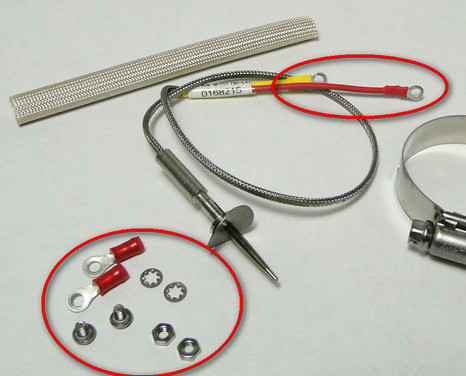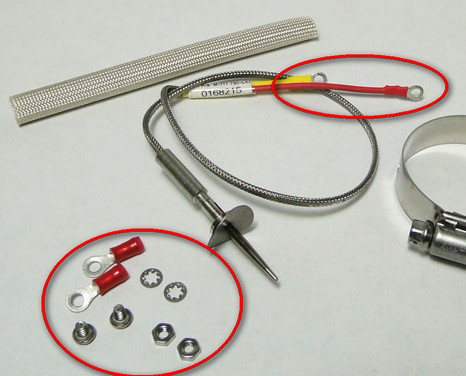Swapping will be a waste of time ;-) If the connectors are good it’s defiitely the probe.
If the connectors are good it’s defiitely the probe
Sadly, the JPI connectors are crap.
They are crimped tags which are screwed together with screws and nuts

It’s a minor miracle that they stay together on a vibrating engine, and sometimes they don’t. A fair # of pilots report sporadic EGT / CHT issues.
Actually the set-up seems fragile.

Yeah, you have the world’s supply of low cost thermocouple connectors in there 
They are not going to like getting water in them, which will happen when flying in rain, etc. The air temp rise across the passage through the cylinder fins, at cruise speed, is around 30C (30K to be proper  ) so not enough to turn water into vapour.
) so not enough to turn water into vapour.
Flyer59 wrote:
Swapping will be a waste of time ;-) If the connectors are good it’s defiitely the probe.
You don’t know if the connectors are ok, until you have them swapped. It doesn’t happen as often as probe, but these do fail. I always want to diagnoze an issue first. A lot of people tend just to throw in new parts. You could see that on alternators for example as well, also on this forum, where people start replacing the alternator, regulator, switch, circuit breaker, only to found out that one of the last parts, for example the over voltage protection had failed.
Troubleshooting first will save money.
Peter wrote:
Sadly, the JPI connectors are crap.They are crimped tags which are screwed together with screws and nuts
I don’t agree and think they are actually quite ok. I often find that these are assembled incorrect. In the JPI installation the star washer should go between the two ring terminals, not under the nut, you will find lots of installation with the star washers under the nut. Another thing that goes wrong often is that the wires are very quite thin. JPI installation instructions says the wiring should be double, to ensure a good crimp contact. Again, you will find a lot of poor crimp contacts, not made according the installation manual.
Reading and doing installation such as suggested seems to be very hard for some.
As Peter said, both the JPI probes and the JPI probe connectors fail regularly. Best is to always have a spare probe available. The screwed connectors do get loose and this is usually seen as intermittent readings and the EDM/G1000/etc. eventually turning off the channel.
The installation in the picture looks fine to me.
@PetitCessnaVoyageur I see that you can remove the complete cowling on the fixed leg C182. That makes maintenance a lot easier than with the RG models where only one lower half can be removed 
@Achimha : The cowling is well made and it’s easy to fully remove it.
As for the lower part, this is one big piece only.
I think 10 minutes is enough to get everything off.
Could you show me exactly what you call the connector ?
Looking for that topic on the forum, I found several posts about sticky valves and clogged injector.
Apart from that rather obvious faulty indication, could we sum up how to interpret a steady lower of higher EGT value on one cylinder ?
Peter showed the picture:

The red and yellow terminals on the probe are connected to white wires going to your cabin. The connection is done with a screw and star washers and hidden inside the gray heat sleeve at the top of the image. It is usually held in place by a tie wrap at each end. Open the tie wraps, move the sleeve and make sure the connectors are correctly installed (star washer between the two crimp terminals) and tighten the screw.
could we sum up how to interpret a steady lower of higher EGT value on one cylinder ?
The answer depends on where the rest of the engine is set up. If you are at peak EGT (i.e. the normal cruise setting) then going either rich or lean from that will lower the EGT.
your answer would be qualified a Jesuits’ one in French, Peter :-)
For example, if peak is around 1450, how would you interpret a sudden and steady rise up to 1650 on one cylinder ?
Or without doing anything, a sudden decrease to a low value ?
How would you make your interpretation regarding to CHT values ?
my question was about the mechanical hypothesis we could make.